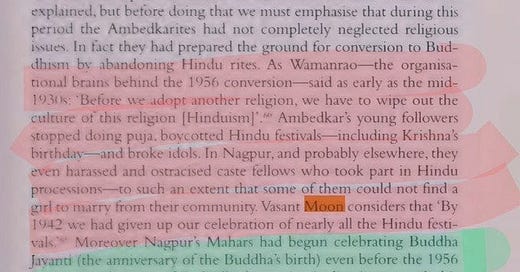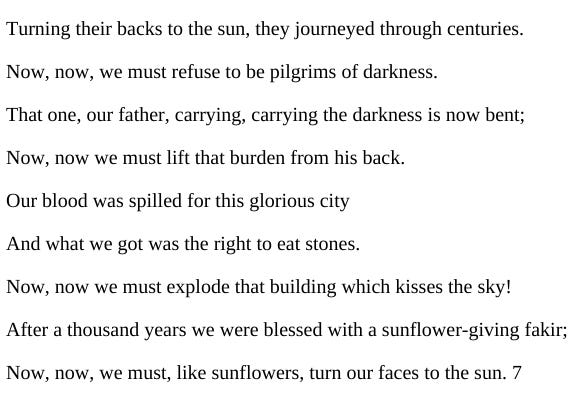Marathwada is one of the most economically poor provinces of Maharashtra. It is regularly drought hit and also sees a lot of farmer suicides. Even after the liberalization of 1991, there has not been a lot of improvement in their standard of living. During the socialist era, it was even worse. This led to the government being seen as the prime avenue of employment. It is not the mistake of the people living there as most governments have ignored their needs, whatever help in farming was provided to them has led to their conditions deteriorating, as the crop pushed was water-intensive, a resource the province lacks.
The Dalits of the province have had a history of activism against the Nizam as an anti-Nizam movement supported by most of the communities[1]. After Independence, a demand emerged from the Dalits to rename the Marathwada University to Dr. Babasaheb Ambedkar University. An agreement was reached between the student body. Dipankar Gupta in his paper quotes[2],
“ The reason why non-Dalit organizations
supported the renaming of Marathwada University as Ambedkar
University, was because they believed that by doing so, they could
make common ground with the Mahars and draw them into the
vortex of the general student movement, from which the Mahars
have all along remained aloof. From past experience the general
opinion amongst the students was that the majority of the Dalits,
who comprise some 26 percent of the student population in the
university, evince no interest when other students agitate for the
lowering of fees, better hostel facilities, availability of text books
at cheaper rates, and so on.”
Dipankar Gupta claims this was a quid-pro-quo, but, I would disagree. I feel this was the path chosen by the student community to integrate their Dalit counterparts and make them part of the larger student community. This was a genuine effort by students who were “Caste Hindus” to ingratiate their Dalit counterparts and through this form a larger student identity based on similar demands of study materials and living conditions. This could have led to greater social cohesion. The Dalit Panthers, a far-left, radical organization, decided to enter this student struggle, Ganghadhar Gadhe took over the student movement and turned it into a Panther movement where all credit will go to the Panthers and Dalits and the “Caste-Hindu” student solidarity will not be taken into consideration. He also went ahead and decided to hurl caste abuses on the “Caste-Hindu” students. Dalit Panthers are an Identitarian organization, social tensions and stratifications help them.
This has not been the first time, Dalit Panthers have used abusive language, Ambedkarite-Communist scholar/intellectual Gail Omvedt, notes in her book, “Reinventing Revolution”[3]:
Their poems showed a full-scale attack not only on economic and political oppression but also on the symbols of brahmanic cultural/symbolic superiority: One day I cursed that mother-fucker God (Keshav Meshram)
No! No! No! A triple rejection
To your economic, social, political, mental, religious moral and cultural pollution.
You ever-living, ever-luminous suns!
Your very touch brings a contagious disease! (V. L.Kalekar) 2
Throw the Brahmans into the Gutter along with the Gita
This was their intellectual critique of “Brahminism”.
They also allied with left wing extremists such as the Naxalites who are a terrorist group according to the Indian government but majority of Maharashtrian Dalits rejected this move.[4]
An Ambedkarite magzine/newspaper called the Dalit Voice[5]:
began to attack all brahmans as “Nazis” and to depict the left movement as simply “Brahmo-Communist.” Eventually it moved to a racially oriented “cultural nationalism” of the non-Aryan theory that identified dalits as blacks and Dravidians, and brahmans as Aryans.
This is not unprecedented as Dalit Panthers were inspired by the Black Panther Party which was a Black Supremacist organization in the USA and employed violent rhetoric and methods to get their demands fulfilled. Their using such racialist rhetoric was not only non-factual but inflammatory. This rhetoric was designed to cause violence between different caste groups.
The Dalit Panther leader, Ganghadhar Gadhe’s caste abuses had the intended effect, large scale violence broke out in the Marathwada region:
Riots affected 1,200 villages in Marathwada, impacting on 25,000 Marathi Buddhist and Hindu Dalits and causing thousands of them to seek safety in jungles. The terrorised Dalits did not return to their villages, despite starvation. This violence was allegedly organised by members of the Maratha community and took many forms, including killings, burning of houses and huts, pillaging of Dalit colonies, forcing Dalits out of villages, polluting drinking water wells, destruction of cattle, and refusal to employ. This continued for 67 days. According to the Yukrant leader, attacks on Dalit were collective and pre-planned. In many villages, Dalit colonies were burned. The burning houses in Marathwada region affected 900 Dalit households. Upper caste rioters demolished essential household items that the Dalit possessed. They even burned the fodder stocks owned by Dalits.
The violence against the Mahars should be unequivocally condemned. This was a barbaric attack on their civil rights and liberties and is not acceptable.
Even though Dalits is written above, people mostly attacked where Mahars. Mangs and Chambhars were not attacked and in some instances attacked the Mahars with the “Caste Hindus”[6] and their heterogeneity is a historical fact and so is their sub-caste discrimination[7].
This conflict was analyzed with two sociologists, whose views I will present:
Dipankar Gupta
Gail Omvedt
Dipankar Gupta views this essentially as an intra-bourgeoise conflict in which poor caste Hindu laborers and Mahar laborers got caught. He rightly claims that the Ambedkarite movement is a movement of the Mahar bourgeoise and feels it is a hindrance to real class unity, as the Mahar bourgeoise use the government policies of land distribution to ensure that they materially prosper and therefore gain land which makes the caste Hindu’s feel persecuted as it is their land or property which the government has taken away from them to give to the landless through the distribution scheme. He then goes on to claim that the Mahar bourgeoise brought this upon the Mahar proletariat by persecuting the Caste Hindu proletariat. He gives examples to cushion his claim such as the example of a Koli and a weaver coming together with Marathas to beat up three Mahar landlords[8], another example he provides is of an inspector who persecuted the caste Hindus heavily and then during these riots was beaten up by the caste Hindus[9]. He claims that only in districts where Mahars showed “self-assertion” was where any violence took place and these were primarily urban districts with rural areas where violence took place[10].
These claims by Dr. Gupta hold some weight but Mahars in Golatgaon were harassed during this period for being Mahars. Therefore, some amount of caste hatred and animosity is present in the region as a whole. Therefore his analysis of making this violence seen as a part of an intra-class warfare does not hold. In a similar vein, Dalits from Telangana who asserted their rights were supported by their comrades during the struggle against the Nizam as reported by Gail Omvedt[11]. Even Mangs who became politically involved pre-Independence were more interested in being treated equally by the Mahars[12].
Gail Omvedt sees this as a caste war and sees this as casteism and hatred for the Dalits as a whole and feels that the Caste Hindus are behind the violence and are to be blamed. While Dr. Gupta’s sociological lens to look at the conflict has shortcomings, it explains it a lot more than the “analysis”, Dr. Omvedt provides. It completely ignores the fact that the Mangs and Chambhars fought against the Mahars in this conflict. The Caste-Hindus did not attack them, so if this was hatred against the “Dalits”, why were Chambhars and Mangs not attacked? Historically, the Mangs have always opposed the Mahars and their political activism, for example, the first educated Mang from the Nizam state, D.N. Kamble had these demands from the Mahars as a whole[13],
(1) Mahars must consider Mangs as equals,
(2) promising Mang young men should have
a chance to go forward,(3) Mahars must not
obstruct Mang processions,(4) Mahars must
not take watandari rights from Mangs,(5) Ambedkar must give as much concern to
the improvement of Mangs as to Mahars.
Many other concerns were raised against the Mahar community and Dr. Ambedkar himself[14].
Even the Shiv Sena supremo, Balasaheb Thackrey was never against the adding of Dr. Ambedkar’s name to the university[15].
“Let me make it clear once again. I never opposed renaming of the university. I had suggested that the name Marathwada University be retained, and Ambedkar’s name be added to it,” Thackeray said in a statement.
The Sena chief’s comments came in response to criticism by political rivals, including one-time protege and present Maharashtra PWD minister, Chhagan Bhujbal, who have questioned the ideological contradictions in the saffron party’s newly-formed alliance with dalit leader Ramdas Athawale’s RPI.
“RPI leader RS Gavai came to my residence and I suggested that Ambedkar’s name be added to the existing name of the university. He liked the idea and phoned Sharad Pawar (the then chief minister) who also gave his approval,” Thackeray said.
“My stance was that while renaming the varsity, the pride of Marathwada region should remain intact,” he said.
I agree that caste hatred to some extent was responsible for this, it was mostly the caste hatred that the Ambedkarites held against the Caste-Hindus that triggered this wave of violence as this started due to the actions of Dalit Panthers and Ganghadhar Gadhe not the Caste-Hindus.
Even the Dalit Panthers in Marathwada were only able to reach Mahars(Buddhists) and not many other Dalit groups according to Gail Omvedt herself[16].
Both Dr. Gupta and Dr. Omvedt do not have any problem with the violence that was undertaken in these riots but against whom the violence was undertaken as Dr. Gupta seems a classical Marxist with his sociological analysis and Dr. Omvedt, an Ambedkarite-Marxist. The former is fine if the proletariat undertook this violence against the bourgeoise irrespective of the caste identity as the Marxists have supported the violence against the Hindus in Moplah violence which was done by “landless Muslim laborers”[17]. Dr. Omvedt wanted the same violence to be undertaken by the lower castes against the Caste Hindus as was undertaken by the Satyasodhaks[18] during the anti-brahmin riots of Maharashtra after the Gandhi Assassination and this ideology of Satyasodhaks is shared by the Dalit Panthers as they saw themselves as the movement which took forward the work of Dr.Ambedkar and Dr.Ambedkar saw himself as the successor of the Satyasodhak movement which was also known as the Non-Brahmin movement[19].
Both analyses are filled with ideological lenses that want to cause chaos and mayhem in society to ensure that the faultlines become so wide that violence becomes a mainstay of society at large, then, they can test out their social theories which led to the violence itself. Such analysis is of no use to those who want to maintain some form of social cohesion and ensure that Indian society at large can move forward in harmony and where prosperity is allowed for all at large.
I am not arguing that anybody must endure any form of discrimination or violence for this cohesion to become a reality, but it would involve an intellectual marginalization of ideologies and philosophies that do not want cohesion in society. Any philosophy that wants to hurt the other or change the other needs to be treated in such a way. A counter-ideology meant to protect shall not lead to any such marginalization.
Even Savarkar who argued for the cohesion of Hindu society did not want people to accept any form of caste discrimination and fought against such discrimination. He argued that Mahars who were his followers should not feel any form of inferiority and should act like men and nobody has the right to scold them for acting like men. He also argued for the dignity of labor and every occupation, which Hindu society has forgotten today. We as a whole community see even highly technical jobs, as lower jobs, this needs to change[20]. The smritis also do not allow people to insult one another based on varna or jati and imposes heavy fines of silver coins for such offenses[21].
A new analytical lens needs to be had which actually tries to understand the reasons behind the conflict and not be the reason for future caste animus and violence.
The lens I propose is built on three pillars, like our republic
Government monopoly of violence
Economic inter-dependence
Ritual inter-dependence
The classical Marxists believe that the Indian Republic is a Fascist Hindu State and the Ambedkarite Marxists believe that it is a Fascist Brahminical Hindu State which hates the lower castes and wants violence to be perpetrated against them and shall do nothing to act against such violence. A Hindu conservative wants the State to have a monopoly on violence such that Matsya-Nyay cannot be practiced by any dominant group on the non-dominant group under any case[22]. Such is not the case with the other ideologies mentioned above as they both seek violence against the bourgeoise and Caste Hindus respectively. These riots were a State failure and proactive action should have been taken by the State to ensure that such violence does not take place.
The Indian State has seen the most amount of caste violence in pre-liberalization days as opposed to post-liberalization days. It can be argued successfully that it was the economic hardship and public-sector job competition which led to such violence as contended by Dr. Gupta[23]. A system used to exist with many flaws which ensured the economic interdependency of the communities on one another while ensuring job security for all. It had many flaws but ensured economic interdependency, which ensured community prosperity for all. That system is dead and our society needs to find a similar setup that allows mobility and ensures prosperity for all communities. The economic hardship was caused by socialism which was practiced by the Indian republic which led to the hunger for public-sector jobs and ensured such conflicts as private-sector jobs were not present in enough quantity to quench the employment thirst of the Indian populace. Socialism as an economic ideology is closest to the program proposed by the classical Marxists and Ambedkarite-Marxists.
Before the conversion of many Dalits to Buddhism, they shared similar festivals and deities with the “Caste Hindus”. The places of worship that they were wrongfully not allowed to enter , now allowed them after the massive temple-entry movements taken by various leaders of the Indian Independence movement. After the conversion of the Mahars to Buddhism, these ritual bonds broke away and another form of social cohesion was lost[24]. The actions taken by the converted Mahars were in the form of breaking the Palaquins(Palkhi)[25] of the deities and in other ways the desecration of the deity’s idols[26]. The converted Mahars also started attacking their Hindu brethren who had not converted and wanted to follow the religion of Hinduism which led to more social disharmony[27].
Sociological lenses which lead to more conflict and breaking down of social cohesion should be rejected intellectually and be marginalized in intellectual settings with conviction as such ideological lenes are to foment and increase conflict between communities rather than trying to find a solution to ensure social harmony.
Such ideological lenses which essentially divide the world into oppressed and oppressor should be squarely rejected because history has never been that idealistically divided between the “good” and “evil” as the left tries to portray the “Oppressor” as some identity groups against whom violence is encouraged and welcomed and portray the “Oppressed” as people who have some inherent right to indulge in violence against the former group. This is not acceptable and this view of oppressor and oppressed must be squarely rejected.
I would also not argue for people to coexist with ideologies which believe that the ones not following their ideology or not part of their specific ingroup, ethnic or racial, have no right to live. Such ideologies need to be fought. I would not ask a Jew to co-exist with a Nazi or Nazism nor I would ask an atheist to co-exist with the faiths who want his/her death.
Author’s note: This would have not been possible without the help of my colleagues at Center for Studies in Hindu Conservatism. I thank @Decode_History and @Savarkar_Stan
Footnotes:
Reinventing revolution : new social movements and the socialist tradition in India(pg 57)
ibid (pg 65)
ibid (pg 72)
ibid
ibid
ibid
ibid
https://clpr.org.in/blog/moplah-rebellion-not-just-a-religious-uprising/
Coyajee report
Reinventing revolution : new social movements and the socialist tradition in India(pg 74)
Dhananjay Keer’s biography “Veer Savarkar”(pg 188)
Brihaspati Smriti
From Untouchable to Dalit by Eleanor Zelliot
ibid
Untouchability by Christopher Jafferlot
ibid






















Delight to read except for the last part